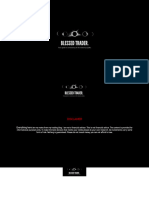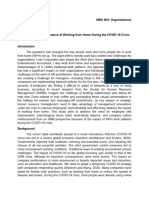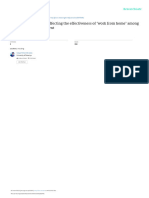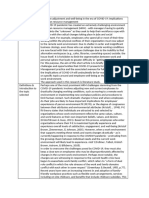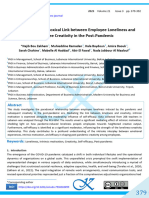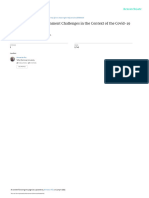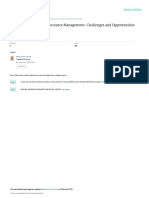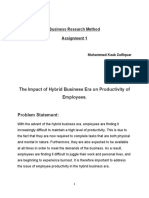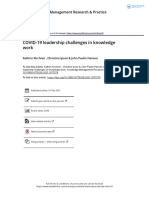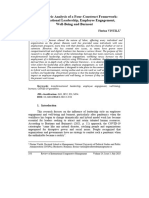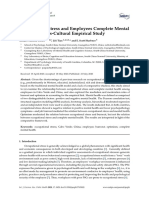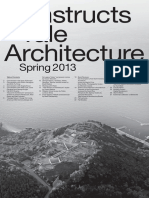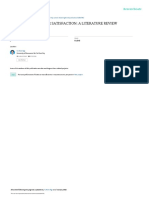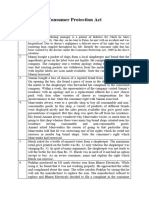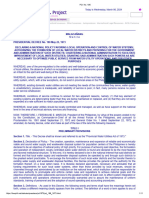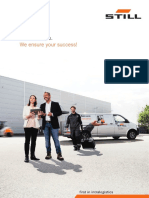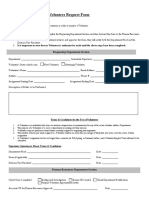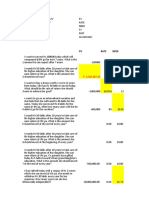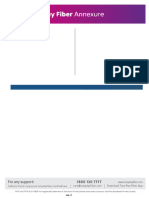Fpsyg 12 710517
Fpsyg 12 710517
Uploaded by
Nanthini KanasanCopyright:
Available Formats
Fpsyg 12 710517
Fpsyg 12 710517
Uploaded by
Nanthini KanasanOriginal Title
Copyright
Available Formats
Share this document
Did you find this document useful?
Is this content inappropriate?
Copyright:
Available Formats
Fpsyg 12 710517
Fpsyg 12 710517
Uploaded by
Nanthini KanasanCopyright:
Available Formats
REVIEW
published: 23 September 2021
doi: 10.3389/fpsyg.2021.710517
Influence of Working From Home
During the COVID-19 Crisis and HR
Practitioner Response
Zhisheng Chen *
College of Economics and Management, Nanjing University of Aeronautics and Astronautics, Nanjing, China
The pandemic has changed the way people work, and more and more people are choosing
to work from home (WFH). Unlike traditional work patterns, this approach has limitations
and has had a significant impact on both organizations and individuals. It also brings
many challenges to the work of HR practitioners. HR practitioners, as key players in
strategic human resource management, need to take advantage of management
innovations under the crisis to improve employees’ work flexibility and effectively address
the impact of working from home. This study aims to address the need for employee skill
improvement, psychological stress relief, work-family balance, and company culture
reinforcement from an HRM perspective because of the impact of WFH work patterns
during the COVID-19 crisis.
Edited by: Keywords: working from home, COVID-19 crisis, influence, HR practitioner, response
Amelia Manuti,
University of Bari Aldo Moro, Italy
Reviewed by:
Muhammad Salman Shabbir,
INTRODUCTION
Dhofar University, Oman
Rachele Mariani, The recent rapid worldwide spread of a novel coronavirus infection (COVID-19 virus) has
Sapienza University of Rome, Italy led to a severe global economic downturn (Al-Mansour and Al-Ajmi, 2020). Governments
*Correspondence:
imposed total lockdown, banning non-essential travel, and requiring the closure of all non-essential
Zhisheng Chen activities. The strict government control measures led to many inconvenient working conditions.
776271378@qq.com Traditional ways of working encountered serious challenges. The impact of COVID-19 on the
global economy was similar to that of the 2008 crisis, although its long-term consequences
Specialty section: were more severe. The impact on company performance is more pronounced in heavily impacted
This article was submitted to areas and industries, such as education and healthcare. We need to adopt a temporary COVID-19
Organizational Psychology, strategy with companies responding quickly (Ahlstrom and Wang, 2020). Many companies
a section of the journal
have opted for flexible work practices, such as working from home to reduce the spread of
Frontiers in Psychology
disease and losses. During the COVID-19 crisis, most people were already using online commerce
Received: 16 May 2021
as well as work from home (WFH) and digital businesses. In response to the outbreak of the
Accepted: 27 August 2021
Published: 23 September 2021
crisis, work patterns changed and the WFH model grew rapidly (Zou et al., 2020b). However,
with the rise of WFH, its corresponding side effects emerged.
Citation:
First, unlike traditional office models, WFH requires people to learn new online office skills
Chen Z (2021) Influence of Working
From Home During the COVID-19
along with virtual work communication skills. There may also be unplanned virtual work
Crisis and HR Practitioner Response. sessions. In addition, working from home requires attention to the confidentiality of office
Front. Psychol. 12:710517. data to prevent leakage. This also raises the need to adapt to the new office environment,
doi: 10.3389/fpsyg.2021.710517 and employees’ WFH skills need to be trained and strengthened.
Frontiers in Psychology | www.frontiersin.org 1 September 2021 | Volume 12 | Article 710517
Chen COVID-19 Crisis and HR Response
Second, when working from home, people lack face-to-face can be subdivided into the person-vocation fit (P-V fit),
communication with colleagues, and once problems arise at person-job fit (P-J fit), person-group fit (P-G fit), and person-
work, it is difficult to solve them quickly through online virtual organization fit (P-O fit). From the division of these four
communication. Online network communication to solve concepts, it can be seen that the fit between the individual
problems leads to increased psychological stress and anxiety. and the work environment should not only be in harmony
This is also extremely harmful to people’s mental health. with the organization at the macro-level, but also harmony with
In addition, WFH leads to the occupation of family members’ the work team at the micro-level, and most importantly, with
space. With the new crown pneumonia epidemic, people tend one’s work (Cable and Derue, 2002; Ahmad, 2012).
to occupy family space for their own work needs. When people The P-V fit is like the P-J fit, but the difference between
work at home, some family tasks, such as childcare or housework, the two is that the P-V fit tends to be more of a professional
need to be shared between them. This creates a conflict between skills match. Without the professional skills required for the
family and work. The imbalance between work and family job, individuals cannot fully adapt to the work environment
can negatively impact job productivity, and HR practitioners and thus constrain themselves, and the specialized skills needed
need to consider how to mitigate this conflict. by WFH require home-based workers to develop appropriate
Even, once the office work style is abandoned, people tend job skills, such as office skills and communication skills. These
to overlook the impact of company culture. Since working skills are different from those required for office work. New
from home people can only communicate and work through training models (online virtual) and content need to be provided.
the virtual space of the Internet, people tend to ignore the Person-job fit refers to the idea that people meet the needs
role of culture. In fact, in times of crisis, the effect of culture of their work, but they also derive satisfaction from their work.
cannot be neglected, and HR practitioners should take various When individual satisfaction is not achieved, anxiety, stress,
measures to guide the role of culture. and psychological breakdowns can occur.
The study found that while WFH has some advantages Person-group fit focuses on the need for harmony between
during this phase, it also has different effects on people, such the team and the work environment, and between the individual
as conflicts with family from taking up home space, inability and the team, in order to achieve optimal work results. Employees
to adapt to telecommuting, and lack of support from leaders who WFH are far from face-to-face interaction in the office;
or co-workers, but the following four areas are the objective they are more likely to communicate online. It is important
and rationale of this study’s discussion. to know how to build online virtual teams. However, they
also face another challenge: the “family and work imbalance.”
1. Employees who Working From Home (WFH) face a home-based In fact, in the WFH model, people spend more time with
work environment where they need to learn special office skills. their families (another fun and challenging “team”). How family
2. WFH can make people feel isolated and can also lead to relationships are managed is also a way to support WFH.
psychological stress. Person-organization fit is an indication of the alignment of
3. During an outbreak, home-based employees often face
individual and organizational goals. Specifically, it means that
conflicts between caring for their families and working. the individual and the organization are aligned in terms of
4. Home-based employees often ignore the potential incentives culture and values. The degree of personal and organizational
of culture under the COVID-19 crisis. culture fit directly affects the performance of employees. The
pandemic brings about a shift in the way people work as well
Therefore, based on the impact of WFH on the above four
as get used to working from home. But they often ignore the
aspects, this study proposes corresponding support measures
importance and role of culture. Organizations need to consider
from the perspective of human resource management.
how to strengthen the role of culture under WFH.
Several studies have shown that there should be consistency
between HRM practices and P-E fit, especially in the context
LITERATURE REVIEW of COVID-19. By integrating strategic HRM with P-E, HRM
practices and policies support P-E fit and thus gain competitive
Person-Environment (P-E) Fit Theory advantage for the firm.
The theory of person-environment fit, first proposed by Lewin
in 1951 (Kahana et al., 1980), considers the positive benefits Hypothesis 1: The P-E fit model can be used to produce
of person-environment matching for individuals. People adapt satisfactory results for organizations and individuals in
to changes in their environment (e.g., those who choose to a pandemic crisis. The application of the model can also
WFH due to a pandemic) and reap the greatest benefits, such explain and support HRM in addressing the impact of
as avoiding the risk of contracting COVID-19 (Chung-Yan, the WFH model on job skills, stress, family, and culture.
2006). In the wake of the new coronavirus outbreak, many
academics and HR practitioners have been thinking about how
to adopt flexible work arrangements (FWAs), such as WFH,
as a more appropriate way of working. Crisis Management During a Pandemic
Different aspects of the P-E fit model have been extensively A crisis is a situation that affects a company’s organizational
studied by several scholars, and the person-environment fit sustainability, performance, and ultimately threatens its viability.
Frontiers in Psychology | www.frontiersin.org 2 September 2021 | Volume 12 | Article 710517
Chen COVID-19 Crisis and HR Response
Managers are concerned that crises can negatively affect different and small, had to adapt their business models to changing
types of businesses at any time and place, as in the case of environmental conditions within a short period of time. New
the new crown pandemic crisis. In the workplace, crisis crown pneumonia affects all corporate characteristics, including
management is an effective response to a crisis at work – working methods, corporate performance, and corporate culture.
discrimination, physical injury, emotional harm, or some type After quickly responding to the new crown pneumonia crisis,
of natural disaster. Implementing crisis management requires they made a series of strategic adjustments to ensure the
managers to understand what people need and how they survival of the business.
can help.
Crisis management can be a challenging task, especially in 1. The problem faced by the company is that the skills of the
an organization’s human resources department (HRD). HRD employees are not sufficient for the WFH pattern. The
plays an important strategic role in crisis management, yet it company needs highly skilled employees to carry out their
is rarely described and analyzed in the literature (Christina work, but the office work skills of the past are no longer
and Fotios, 2015). Indeed, from a practical perspective, crisis sufficient to meet the company’s needs.
management has been a neglected area of HRM, despite the 2. The psychological stress caused by WFH to employees has
growing recognition of the impact of different crises on a negative impact on the achievement of corporate goals.
performance outcomes. It is recommended that an effective 3. This conflict cannot be avoided due to the replacement of
crisis management team (CMT) be established to address issues office space with home space. The company needs to consider
of concern throughout the organization (Blythe, 2004). As a sacrificing home space to meet the work needs of employees.
member of the CMT, the HR director is responsible for providing 4. The role of corporate culture is significantly weakened by
leadership to the company and its employees during a crisis the loss of physical distance contact.
event (COVID-19).
Some agile companies have adopted strategies that include
From the perspective of HR managers, a crisis-driven HR
flexible HRM policies and practices, which are effective in the
strategy is more effective. They believe that it is much easier
short term, but in the present and post-COVID-19 era crisis
to manage employees during a crisis than to manage other
impact, companies need to focus on diversity and long-term
resources. The design of crisis management processes requires
HR strategy research.
a high level of strategic integration between job skills, stress
relief, work-family balance, and corporate culture (Wang
et al., 2009). Impact on Employees
The approach to crisis management used by HR should During the COVID-19 pandemic, the homes of employees
be different from that used by other functions. HR leaders suddenly became the main place of economic activity. Many
address organizational crises through crisis management countries have used their homes as a buffer against economic
preparedness, including improving job skills, balancing work downturns and have taken action to support this WFH (Jenkins
and family, relieving psychological stress, and strengthening and Smith, 2021). We argue that businesses and governments
culture (Lockwood, 2005). see housing as a supporting pillar for economic development.
Even employers who offer work-at-home jobs can be seen as
Hypothesis 2: COVID-19 has a serious impact on the an effective way to deal with the epidemic. It takes everyone
survival of the company, and the crisis management – managers, employees, and their families – to adapt.
awareness of HR practitioners can reduce the impact of Advances in technology have made it possible for people
the crisis in four aspects: work skill improvement, to WFH, and this has affected the way people, especially staff.
psychological stress relief, family-work balance, and It has also benefited some companies during the difficult times
cultural role. of the pandemic. Companies have adopted the WFH model,
relying on modern technology to reduce the corresponding
regulatory costs (White, 2019).
Work from home can improve performance due to its
IMPACT OF WFH ON ENTERPRISES, flexibility. Employees can decide when and where to work.
EMPLOYEES, AND HR PRACTITIONERS Many employees are satisfied with the flexibility they get from
the WFH model. Working from home can also improve
Impact on Businesses performance because there are no interruptions, employees
The new crown pneumonia pandemic caused widespread have fewer breaks, and there is no contact with co-workers
devastation in countries around the world. Tens of millions (Garg and Rijst, 2015).
of people were infected; the economy was in recession and However, some people use their home as a free workplace
many people lost their jobs. Governments implemented many that can be used inexpensively in an emergency (e.g., COVID-
controls. These measures slowed the spread of the epidemic 19) but neglects its function as a place to live. As a result,
and some businesses were severely damaged. employees are faced with corresponding challenges and problems:
A number of studies on the impact of the COVID-19 crisis First, the model requires upgrading employees’ WFH work
on companies can draw preliminary conclusions about crisis skills. This demand for WFH is driving the digitization of
management in companies. Companies in all industries, large human work at an alarming rate due to the explosion of
Frontiers in Psychology | www.frontiersin.org 3 September 2021 | Volume 12 | Article 710517
Chen COVID-19 Crisis and HR Response
COVID-19 (Savi, 2020). Employees need to work and and uncertainty. As the company continues to adjust its HR
communicate online, which requires special skills, such as new policies and practices in the face of COVID-19, it will be crucial
office skills and online communication skills. However, some to understand how these outbreaks affect employee P-E fit,
specific industries, such as low-skilled services, cannot adopt and how to address dangerous misfits. The pandemic has had
this model. In addition, network accessibility and online task a serious impact on HRM policies and practices in different
suitability can affect the feasibility of the model. industries. The prominent impact is manifested in a series of
Second, internal psychological stress. Research has shown challenges for HR practitioners as a result of the shift in
that a lack of social support and the feeling of working alone work patterns.
can lead to loneliness (Rook, 1985), and also to stress (Liu
and Guo, 2007). Some individuals are more stressed during 1.
What training approaches and innovative training
a pandemic because they are unable to communicate their content do HRM adopt for the WFH model where work
anxiety to others. In addition, with uncertainty about the future, skills differ from the traditional office requirements of
such as layoffs, pay cuts, and bankruptcies, employees experience the past?
a serious increase in internal stress. Further studies also found 2. How can HRM consider mitigating the increased internal
that employees’ psychological stress also has a direct negative stress of home-based workers, which is damaging to both
impact on hiring commitment (Ali and Kakakhel, 2013; Velnampy individual and organizational performance?
and Aravinthan, 2013). 3. How can HRM consider developing a more reasonable
Third, employees who WFH often have conflicts between work-family balance plan, given the negative impact of
taking care of their families and their jobs during an epidemic. workplace conflicts with families?
Telecommuters work longer hours than those who work in 4. As one of the important promoters of corporate culture,
formal offices, which is a major reason for work-family imbalance. how can HR practitioners enhance the role of culture in
Their work style is flexible so they have unlimited access to the new work model?
online offices (Song and Gao, 2020); this model also breaks
Not surprisingly, the COVID-19 pandemic has forced HR
down the boundaries between work and non-work. It reduces
professionals to rethink and redefine their roles as organizations
the company’s need for office space but increases the employees’
begin to adapt to the way people work (Nutsubidze and
need for living space because of the need for extra rooms to
Schmidt, 2021).
WFH (Behrens et al., 2021). In addition, when some employees
need to take care of their families, their families may stay at
Hypothesis 3: Organizations may adopt the WFH work
home while they are working (Kara et al., 2021). Employees
model in the event of a pandemic, but it presents four
expect a dedicated workspace at home with fewer distractions
unprecedented challenges for companies, individuals,
from family members, which is associated with a better work-
and HR practitioners. In the face of the crisis and
family balance (Allen et al., 2021).
challenges, HR management needs to respond and
Finally, the role of culture is weakened. In WFH situations,
react accordingly.
the functions embodied in corporate culture are weakened,
such as leadership culture and cooperative culture. The manager’s
ability to control and supervise subordinates is also affected.
In addition, managers may be concerned about the impact of HR PRACTITIONERS’ REACTIONS TO
working from home on contracts and employee reputation.
THE IMPACT OF WFH
Unlike traditional office work, this model reduces opportunities
for intimate psychological interactions while reducing face-to- The main impacts during WFH are job skill requirements,
face communication. While information and communication psychological stress, conflict with family, and WFH culture.
technology (ICT) can facilitate online interaction and HR practitioners need to provide feedback and strategies to
collaboration with colleagues, they lack the enthusiasm for these impacts.
face-to-face interaction, which is seen as key to developing
closer social relationships (Vayre and Pignault, 2014). Failure
to address the lack of interpersonal interaction can ultimately Upgrading WFH Skills: Innovative Training
lead to employees feeling disconnected from the corporate Content and Methods
culture and work environment (Marzban et al., 2021; During the pandemic, employees lost their motivation to advance
Wilson, 2021). in their careers because they were working from home too
long. They needed to develop the knowledge and skills to
Impact on HR Practitioners thrive in their current environment. As remote workers become
In the field of human resource management, it has long been more interested in improving their capabilities, HR practitioners
recognized that employees feel frustrated and stressed in situations should take the lead in organizing relevant skills training to
of danger or uncertainty, such as COVID-19 (Kumar et al., meet employees’ desire to learn and grow. Predictably, when
2021). The stress caused by an outbreak can provide HRM employees WFH, they will be trained to improve their
practitioners with constructive insights to help them assess performance and support the company’s growth in the post-
opportunities and developments in an environment of threat pandemic era (Caligiuri et al., 2020).
Frontiers in Psychology | www.frontiersin.org 4 September 2021 | Volume 12 | Article 710517
Chen COVID-19 Crisis and HR Response
Countless practical examples show that HRM has developed represents HRM efforts to help employees balance work and
strategies to overcome the disadvantages of the pandemic. These family responsibilities (Thomas and Ganster, 1995).
strategies, such as innovations in training methods and content, HR practitioners can provide stress relief training, such as
contribute to improving employees’ competencies, maintaining stressor analysis, threat and infection risk prevention, mental
their motivation, and reducing their psychological stress (Gigauri, health in WFH, and work-family balance. To reduce the risk
2020; Zou et al., 2020a). of infection in face-to-face training, HR can provide online
Human resource management increasingly draws inspiration virtual training.
from online virtual training designs. When working from home, In addition, the sustainability of HRM policies and practices
employees can learn a wide range of skills through online plays an important role in reducing employee dissatisfaction
courses (Hamouche, 2021). To meet the needs of their own and job stress. Important HRM policies related to employees
continuous development in a pandemic situation, HR departments include compensation and benefits, performance evaluation,
are conducting training needs surveys and coordinating with promotion, and transfer. With the impact of the pandemic,
other departments to design online training courses. It is the sustainability of these policies helped to alleviate the mental
conceivable that online virtual classes in the future will become stress and job slack of the work-at-home employees.
the new normal for training in the era of the new pneumonia
crown (Alhat, 2020).
In addition to the usual vocational skills training, the ongoing One Support: Work-Family Balancing
crisis has created new training needs, such as ICT. In particular, Some companies affected by new coronary pneumonia have
ICT can also be used to train recruits in work and collaboration had to adopt flexible working practices to reduce the risk of
skills. Many companies now see the need to prepare for a an outbreak. According to various analyses, WFH can help
long-term pandemic as standard work content decreases and employees balance career development and work. It can also
the WFM model remains intact. Currently, improving employee reduce commuting time and companies can save on office
skills through training is the most effective use of time costs by having smaller office spaces (Gajendran and Harrison,
(Hamouche, 2021). This is driving a growing demand for 2007). However, WFH has a significant impact on the work-
technology-driven training programs around the world. home balance (Perrigino and Raveendhran, 2020). WFH often
Often, many employees must use computers and the Internet blurs the boundaries between work and home roles (Schieman
while working from home. Human resource practitioners value and Young, 2010). Even people who WFH are not satisfied
the need for information security training. Employees who with the distribution of family tasks after working for a long
WFH should receive basic training on cybersecurity hazards period of time. Long working hours and occupying home space
and how to effectively prevent information risks and avoid also increase the likelihood of work–family conflict (Solís,
leaks of private company data. 2016). We believe that helping employees achieve work-life
balance should be a key part of HR practices and strategies
if it ensures optimal employee satisfaction, rather than leaving
Alleviate Psychological Stress Caused them feeling dissatisfied, exhausted, and stressed.
by WFM Research has found that work–family conflict is more
According to the principle of personal preference in economics, correlated with work schedule flexibility when working from
not everyone wants to WFH (Perrigino and Raveendhran, home. In fact, WFH is divided into traditional (typical “9–5”
2020). The work-family conflict caused by WFH is a major working hours) and non-traditional (irregular working hours;
source of stress for employees and has a negative impact on Duxbury et al., 1996). Non-traditional WFH has a high degree
their psychological health (Sharma et al., 2016); this imbalance of flexibility in terms of work schedule, which is different
can lead to managers’ negative perception of WFH and affect from traditional work hours. When developing WFH policies,
their beliefs; and pressure from professional groups can also HR practitioners should fully consider the individual preferences
affect HR practitioners’ idea of working from home. HR of WFH employees, based on the different characteristics of
practitioners can take some appropriate measures to alleviate WFH employees (Golden, 2012). Based on individual preferences,
this stress. HR policies should allow telecommuters to flexibly schedule
Psychologists believe that a home-friendly workplace can their working hours to meet their individual needs. Flexible
help reduce employee stress and depressive symptoms (Shepherd- work schedules for non-traditional WFH can alleviate work–
Banigan et al., 2016). Based on a cost–benefit analysis, we believe family conflicts during a pandemic.
that improved work-family relationships can influence In addition, the potential for work–family conflict increases
organizational goals, such as improved organizational with longer work hours. During the COVID-19 pandemic,
performance and corporate reputation. HR practitioners should telecommuters used their home space as an office. Unlike
play an important role in establishing such a workplace. Although traditional office work, they spent more time on work without
employees WFH, HR practitioners can develop family-friendly realizing it (Dockery and Bawa, 2020). The relatively less time
work programs, interact with employees and their families, spent with family members undoubtedly leads to strong work-
and show concern for employees during the COVID-19 crisis. at-home conflicts. Even some telecommuters work hard on
The program usually consists of a “supportive family-friendly weekends and holidays. Long hours of WFH can increase
program” and a “supportive family management team,” which family unhappiness and stress, which can affect the family
Frontiers in Psychology | www.frontiersin.org 5 September 2021 | Volume 12 | Article 710517
Chen COVID-19 Crisis and HR Response
atmosphere (Song and Gao, 2018). HR practitioners should concluded that leadership culture in crisis enables employees
consider a policy of not working long hours when developing to successfully deal with the effects of crisis (Colville
work schedules. An effective HR policy can alleviate the excessive and Murphy, 2006). In the current work model, managers
work hours caused by remote workers who work too many with leadership skills are able to meet employees’
hours at home. expectations and guide the company through the effects of
Finally, the assignment of family tasks is particularly the pandemic.
important for home-based work balance. Indicators of family An overly idealized employee culture, such as high
functioning include perceptions of the quality of relationships performance and high results orientation, can lead to cultural
and the degree of equity in how family tasks are shared barriers during WFH. The perception is that leaders want
within the family. These indicators of family functioning are employees to work properly in the office, and when they WFH,
used to indicate the extent of work–family conflict (Bankwest managers cannot directly supervise them or communicate face-
Curtin Economics Centre, Curtin University School of to-face about their performance. This is why employees do
Economics et al., 2017). Family members will perceive not want to WFH (Lott and Abendroth, 2019). HR practitioners
that the division of responsibilities within the family is fair should encourage managers to rationally evaluate the performance
and reasonable, and rationality will influence the relationships of employees who WFH through an online evaluation system.
between family members. Companies, especially human In addition, work-from-home support programs for HR
resource practitioners, should provide employment assistance practitioners can help reduce the cultural barriers in the
programs for remote workers during the pandemic, WFH model.
including family member relationship management,
reconciliation of family and work responsibilities, and post-
conflict resolution. FUTURE RESEARCH DIRECTION
Work from home will continue to have an impact on business
Cultural Reinforcement in the WFH Model and work. In addition to the recommendations, the study
Corporate culture is a complex network of corporate norms, has already provided, there are some theoretical and practical
organizational vision, and member attitudes with specific group studies on the HR side that need to be strengthened in the
characteristics. It can be reinforced through training, punishment, current and post-pandemic era: Organizations use E-HR in
rewards, etc. (Kuchinke, 1999). Culture needs to be adapted the WFH model to help HR practitioners work more efficiently;
to the environment external to the organization, especially in during the pandemic, traditional offline HR operations were
the context of the new crown pandemic crisis. As the impact replaced by online work. Virtual online HR management is
of the pandemic crisis expands and the psychological stress required to complete recruitment and staffing; unlike office
of work-at-home employees increases, corporate culture will workflow, HR practitioners need to optimize job responsibilities
become a focus of attention for managers or HR practitioners. and workflow for employees working from home; and the
If HR practitioners want to reduce the disruption of WFH impact of the crisis has led to a more popular relationship-
and improve WFH arrangements, they should create a WFH oriented HR system. This system brings employees tighter
culture with high execution and low barriers. HR practitioners together with the organization and brings a strong organizational
need to focus on the following areas: commitment; in a pandemic situation, a period HR strategy
When selecting and hiring talent during a pandemic, HR should be developed to help the organization overcome the
needs to focus on whether these individuals are a good fit crisis; and corporate social responsibility helps companies to
for the company culture. P-E fit theory states that individuals improve performance and better position themselves during
will choose companies when their ideas align with the the pandemic.
organization’s culture, WFM model, and development philosophy.
Newly hired employees still need to receive initial culture
training from the company. LIMITATIONS
Because of the pandemic, working from home requires a
more collaborative spirit. Remote workers enhance The study needs to strengthen the literature citations. Though
communication and collaboration with each other through the study reviews a range of literature and what we have
virtual organizations. Despite their different backgrounds and reviewed is current and relevant, the recommendations need
lack of face-to-face interaction, a collaborative culture is more to be bolstered by the previous literature. In addition, this
likely to emerge in the WFH model (Borkovich and Skovira, paper only analyzes the effects of WFH on people during
2020; Singh and Kumar, 2020). COVID-19 and should compare the effect before the COVID-19
Research has shown that leadership is a culture-specific outbreak. Therefore, the study needs to compare and analyze
element. HR practitioners should have some leadership in the influence from the timeline.
times of crisis to help their companies survive the crisis. In the future, we also need to consider: Does WFH still
We believe that HR practitioners with strong leadership widespread in the post-COVID-19 era? If there are still many
skills are able to identify and effectively deal with cultural companies using the WFH model, what is the impact on people
conflicts in different work models. Several studies have at that time?
Frontiers in Psychology | www.frontiersin.org 6 September 2021 | Volume 12 | Article 710517
Chen COVID-19 Crisis and HR Response
CONCLUSION stress under the crisis, work-family imbalance, and corporate
culture reinforcement. Focusing on these issues has benefits for
COVID-19 has affected the lives of many people. To prevent the both organizations and individuals, especially in the current crisis.
future spread of this pandemic, many organizations have had to Future research will also need to consider the implications of
change their traditional ways of working. The advent of WFH this work model in the post-COVID-19 era.
has brought some convenience, but as the impact of the pandemic
has deepened, it has also had certain effects on organizations,
employees, and HR practitioners that will continue in the post- AUTHOR CONTRIBUTIONS
pandemic era. Through a discussion of the relevant literature,
this study argues that during the COVID-19 crisis, when people ZC contributed to conception and design of the study. He also
were working from home, our managers, especially HR practitioners, contributed to manuscript revision, read, and approved the
needed to address issues, such as job skills enhancement, employee submitted version.
REFERENCES Garg, A. K., and Rijst, J. v. D. (2015). The benefits and pitfalls of employees
working from home: study of a private company in South Africa. CBRDC
Ahlstrom, D., and Wang, L. C. (2020). Temporal strategies and firms’ speedy 11, 36–49. doi: 10.22495/cbv11i2art3
responses to COVID-19 [Editorial Material; Early Access]. J. Manag. Stud. Gigauri, I. J. (2020). Influence of Covid-19 crisis on human resource management
5, 592–596. doi: 10.1111/joms.12664 and companies’ response: the expert study. IJMSBA 6, 15–24. doi: 10.18775/
Ahmad, K. Z. (2012). The mediating effect of person-environment fit on the ijmsba.1849-5664-5419.2014.66.1002
relationship between organisational culture and staff turnover. Asian J. Soc. Golden, T. D. (2012). Altering the effects of work and family conflict on
Sci. 8 62–71. doi: 10.5539/ass.v8n2p62. exhaustion: telework during traditional and nontraditional work hours. J.
Alhat, S. (2020). Virtual classroom: a future of education post-COVID-19. Bus. Psychol. 27, 255–269. doi: 10.1007/s10869-011-9247-0
Shanlax Int. J. Educ. 8, 101–104. doi: 10.34293/education.v8i4.3238 Hamouche, S. (2021). Human resource management and the COVID-19 crisis:
Ali, N., and Kakakhel, S. J. (2013). Relationship between occupational stress implications, challenges, opportunities, and future organizational directions.
and organizational commitment (empirical evidence from pharmaceuticals J. Manag. Organ., 1–16. doi: 10.1017/jmo.2021.15
industry). J. Manag. Sci. 2:292 Jenkins, F., and Smith, J. (2021). Work-from-home during COVID-19: accounting
Allen, T. D., Merlo, K., Lawrence, R. C., Slutsky, J., and Gray, C. E. (2021). for the care economy to build back better. Econ. Labour Relat. Rev. 32,
Boundary management and work-nonwork balance while working from 22–38. doi: 10.1177/1035304620983608
home. Appl. Psychol-Int. Rev. 70, 60–84. doi: 10.1111/apps.12300 Kahana, E., Liang, J., and Felton, B. (1980). Alternative models of person-
Al-Mansour, J. F., and Al-Ajmi, S. A. (2020). Coronavirus ‘COVID-19’ – supply environment fit: prediction of morale in three homes for the aged. J. Gerontol.
chain disruption and implications for strategy, economy, and management. 35, 584–595. doi: 10.1093/geronj/35.4.584
JAFEB. 7, 659–672. doi: 10.13106/jafeb.2020.vol7.no9.659 Kara, S. B. K., Günes, D. Z., and Tüysüzer, B. S. (2021). Work-family conflict
Bankwest Curtin Economics Centre, Curtin University School of Economics during working from home due to pandemic: a qualitative research on
(2017). When two worlds collide: working from home and family functioning. female teachers. Int. J. Curric. Instruct. 13, 251–273.
Int. Labour Rev. 23, 609–630. doi: 10.1111/ilr.12058. Kuchinke, K. P. (1999). Leadership and culture: work-related values and
Behrens, K., Kichko, S., and Thisse, J. F. (2021). Working from home: too leadership styles among one company’s U.S. and German tele
much of a good thing? CEPR Discussion Papers. communication employees. Hum. Resour. Dev. Q. 10, 134–154. doi: 10.1002/
Blythe, B. T. (2004). The human side of crisis management. JOH 37–39. hrdq.3920100205
Borkovich, D. J., and Skovira, R. J. (2020). Working from home: cybersecurity Kumar, P., Kumar, N., Aggarwal, P., and Yeap, J. A. (2021). Working in lockdown:
in the age of COVID-19. Issues Inf. Syst. 21, 234–246. doi: 10.48009/4_ the relationship between COVID-19 induced work stressors, job performance,
iis_2020_234-246. distress, and life satisfaction. Curr. Psychol., 1–16. doi: 10.1007/
Cable, D. M., and Derue, D. S. (2002). The convergent and discriminant validity s12144-021-01567-0
of subjective fit perceptions. J. Appl. Psychol. 87, 875–884. doi: Liu, L.-J., and Guo, Q. (2007). Loneliness and health-related quality of life for
10.1037/0021-9010.87.5.875 the empty nest elderly in the rural area of a mountainous county in China.
Caligiuri, P., De Cieri, H., Minbaeva, D., Verbeke, A., and Zimmermann, A. Qual. Life Res. 16, 1275–1280. doi: 10.1007/s11136-007-9250-0
(2020). International HRM insights for navigating the COVID-19 pandemic: Lockwood, N. R. (2005). Crisis management in today’s business environment:
implications for future research and practice. J. Int. Bus. Stud. 51, 697–713. HR’s strategic role. Hr Magazine, 1–10.
doi: 10.1057/s41267-020-00335-9 Lott, Y., and Abendroth, A. (2019). Reasons for not working from home in
Christina, N., and Fotios, V. (2015). HR’s strategic role in terms of crisis an ideal worker culture: why women perceive more cultural barriers. WSI
management. Int. J. Tech. Res. Appl. 7–8. Working Papers.
Chung-Yan, G. A. (2006). Adapting to the work environment: an integrative Marzban, S., Durakovic, I., Candido, C., and Mackey, M. (2021). Learning to
model of adaptive skills, person-environment fit, and work stress. (Canada: work from home: experience of Australian workers and organizational
Doctoral dissertation, University of Guelph). representatives during the first Covid-19 lockdowns. CRE 23, 203–222. doi:
Colville, I. D., and Murphy, A. (2006). Leadership as the enabler of strategizing 10.1108/JCRE-10-2020-0049
and organizing. Long Range Plan. 39, 663–677. doi: 10.1016/j.lrp.2006. Nutsubidze, N., and Schmidt, D. A. (2021). Rethinking the role of HRM during
10.009 COVID-19 pandemic era: case of Kuwait. RSEP 6, 1–12.
Dockery, M., and Bawa, S. (2020). Working from home in the COVID-19 Perrigino, M. B., and Raveendhran, R. (2020). Managing remote workers during
lockdown. NCVER’s International Tertiary Education Research Database. quarantine: insights from organizational research on boundary management.
Duxbury, L. E., Higgins, C. A., and Thomas, D. R. (1996). Work and family Behav. Sci. Policy. 6, 87–94. doi: 10.1353/bsp.2020.0019
environments and the adoption of computer-supported supplemental work- Rook, K. S. (1985). “The functions of social bonds: perspectives from research
at-home. J. Vocat. Behav. 49, 1–23. doi: 10.1006/jvbe.1996.0030 on social support, loneliness and social isolation,” in Social Support: Theory,
Gajendran, S., and Harrison, D. A. (2007). The good, the bad, and the unknown Research and Applications eds. G. Sarason et al., (Leiden, Netherlands:
about telecommuting: meta-analysis of psychological mediators and individual Springer), 243–267.
consequences. J. Appl. Psychol. 92, 1524–1541. doi: 10.1037/0021-9010.92.6. Savi, D. (2020). COVID-19 and work from home: digital transformation of
1524 the workforce. Grey J. 16, 101–104.
Frontiers in Psychology | www.frontiersin.org 7 September 2021 | Volume 12 | Article 710517
Chen COVID-19 Crisis and HR Response
Schieman, S., and Young, M. (2010). Is there a downside to schedule control Wang, J., Hutchins, H. M., and Garavan, T. N. (2009). Exploring the strategic
for the work-family interface? J. Fam. Issues 31, 1391–1414. doi: role of human resource development in organizational crisis management.
10.1177/0192513X10361866 Hum. Resour. Dev. Rev. 8, 22–53. doi: 10.1177/1534484308330018
Sharma, J., Dhar, R. L., and Tyagi, A. (2016). Stress as a mediator between work-family White, D. R. (2019). Agency theory and work from home. Labour 33, 1–25.
conflict and psychological health among the nursing staff: moderating role of doi: 10.1111/labr.12135
emotional intelligence. Appl. Nurs. Res. 30, 268–275. doi: 10.1016/j.apnr.2015.01.010 Wilson, J. (2021). Impact of work from home policies on workplace productivity
Shepherd-Banigan, M., Bell, J. F., Basu, A., Booth-Laforce, C., and Harris, J. R. and employee sentiments during the COVID-19 pandemic.
(2016). Workplace stress and working from home influence depressive Zou, P., Huo, D., and Li, M. (2020b). The impact of the COVID-19 pandemic
symptoms among employed women with young children. Int. J. Behav. Med. on firms: a survey in Guangdong Province, China. Glob. Health Res. Policy
23, 102–111. doi: 10.1007/s12529-015-9482-2 5:41. doi: 10.1186/s41256-020-00166-z
Singh, M. K., and Kumar, V. (2020). Impact of Covid-19 pandemic on working Zou, C., Zhao, W., and Siau, K. (2020a). COVID-19 calls for remote reskilling
culture: an exploratory research among information technology (IT) and retraining. Cutter Bus. Technol. J. 33, 21–25.
professionals in Bengaluru, Karnataka (India). XAAT XII:3184
Solís, M. S. (2016). Telework: conditions that have a positive and negative impact Conflict of Interest: The author declares that the research was conducted in
on the work-family conflict. ARLA 29, 435–449. doi: 10.1108/ARLA-10-2015-0289 the absence of any commercial or financial relationships that could be construed
Song, Y., and Gao, J. (2018). Does telework stress employees out? A study on as a potential conflict of interest.
working at home and subjective well-being for wage/salary workers. IZA
Discussion Papers. 2649–2668. Publisher’s Note: All claims expressed in this article are solely those of the
Song, Y., and Gao, J. (2020). Does telework stress employees out? A study on authors and do not necessarily represent those of their affiliated organizations,
working at home and subjective well-being for wage/salary workers. J. or those of the publisher, the editors and the reviewers. Any product that may
Happiness Stud. 21, 2649–2668. doi: 10.1007/s10902-019-00196-6 be evaluated in this article, or claim that may be made by its manufacturer, is
Thomas, L. T., and Ganster, D. C. (1995). Impact of family-supportive work not guaranteed or endorsed by the publisher.
variables on work-family conflict and strain: a control perspective. J. Appl.
Psychol. 80, 6–15. doi: 10.1037/0021-9010.80.1.6 Copyright © 2021 Chen. This is an open-access article distributed under the terms
Vayre, E., and Pignault, A. (2014). A systemic approach to interpersonal of the Creative Commons Attribution License (CC BY). The use, distribution or
relationships and activities among French teleworkers. N. Technol. Work. reproduction in other forums is permitted, provided the original author(s) and the
Employ. 29, 177–192. doi: 10.1111/ntwe.12032 copyright owner(s) are credited and that the original publication in this journal
Velnampy, T., and Aravinthan, S. (2013). Occupational stress and organizational is cited, in accordance with accepted academic practice. No use, distribution or
commitment in private banks: a Sri Lankan experience. JFA 5, 254–267. reproduction is permitted which does not comply with these terms.
Frontiers in Psychology | www.frontiersin.org 8 September 2021 | Volume 12 | Article 710517
You might also like
- Lesson 1 Orderblock Propulsion Block BreakerDocument16 pagesLesson 1 Orderblock Propulsion Block BreakerNelwan Natanael100% (2)
- Business FinanceDocument22 pagesBusiness Financeahmie banez100% (1)
- Impact of Covid-19 On Employee Engagement and CultureDocument6 pagesImpact of Covid-19 On Employee Engagement and CultureInternational Journal of Innovative Science and Research TechnologyNo ratings yet
- Case Study - Organizational Behavior - FinalDocument15 pagesCase Study - Organizational Behavior - FinalRocel NavajaNo ratings yet
- Identifying The Factors Affecting The Effectiveness of Work From Home' Among Middle-Level ManagementDocument23 pagesIdentifying The Factors Affecting The Effectiveness of Work From Home' Among Middle-Level ManagementKavittra KarthigesuNo ratings yet
- Innovative HRMPracticesfor Improving Employee Resilienceinthe Eraof COVIDDocument9 pagesInnovative HRMPracticesfor Improving Employee Resilienceinthe Eraof COVIDtiwariharshita85No ratings yet
- Title at the top of the pageDocument14 pagesTitle at the top of the pageraifintiyaNo ratings yet
- A Look at The Benefits and Challenges of Working RemotelyDocument15 pagesA Look at The Benefits and Challenges of Working RemotelydonpheartNo ratings yet
- 10-1108 - AAAJ-06-2020-4657 - Lain LainDocument12 pages10-1108 - AAAJ-06-2020-4657 - Lain LainMina JayantiNo ratings yet
- Impact of Work From Home On Employees: Submitted To: Dr. Jaimini Yagnik By: Muskan Pandey (201700510010097)Document47 pagesImpact of Work From Home On Employees: Submitted To: Dr. Jaimini Yagnik By: Muskan Pandey (201700510010097)Muskan PandeyNo ratings yet
- COVID-19 Oriented HRM Strategies Influence On Job and Organizational Performance Through Job-Related AttitudesDocument29 pagesCOVID-19 Oriented HRM Strategies Influence On Job and Organizational Performance Through Job-Related Attitudesmaria.centeruniNo ratings yet
- The Impact of Hybrid-Work-Model' On Job Satisfaction: Aradhana S. Kumar & Jayanti Banerjee DasDocument12 pagesThe Impact of Hybrid-Work-Model' On Job Satisfaction: Aradhana S. Kumar & Jayanti Banerjee DasTJPRC PublicationsNo ratings yet
- Journal of Interdisciplinary Cycle Research ISSN NO: 0022-1945Document8 pagesJournal of Interdisciplinary Cycle Research ISSN NO: 0022-1945RockstarNo ratings yet
- Employee Adjustment and Well-Being in The Era of COVID (2020) 17.57.45Document6 pagesEmployee Adjustment and Well-Being in The Era of COVID (2020) 17.57.45Ana AntunesNo ratings yet
- Exploring Motivation and Commitment On Job Satisfaction and Employee Performance in Work From Home (WFH)Document15 pagesExploring Motivation and Commitment On Job Satisfaction and Employee Performance in Work From Home (WFH)Hamza NaeemNo ratings yet
- Doradiana,+a6 FACTORS+THAT+INFLUENCE 59-74Document16 pagesDoradiana,+a6 FACTORS+THAT+INFLUENCE 59-74Nanthini KanasanNo ratings yet
- Employee Adjustment and Well-Being in The Era of COVID-19: Implications For Human Resource ManagementDocument20 pagesEmployee Adjustment and Well-Being in The Era of COVID-19: Implications For Human Resource ManagementSarita MoreNo ratings yet
- 2746-Article Text-26360-2-10-20220928Document14 pages2746-Article Text-26360-2-10-2022092822915041No ratings yet
- Trends in Human Development For 2022Document27 pagesTrends in Human Development For 2022Magdalena ObarskaNo ratings yet
- Group-8 Critique Research ArticleDocument8 pagesGroup-8 Critique Research ArticleMaye LisingNo ratings yet
- Muskan Miglani MPR ProjectDocument46 pagesMuskan Miglani MPR ProjectMuskan MiglaniNo ratings yet
- Work Environment and Its Influence On Job Burnout and Organizational Commitment of BPO AgentsDocument12 pagesWork Environment and Its Influence On Job Burnout and Organizational Commitment of BPO AgentsPsychology and Education: A Multidisciplinary JournalNo ratings yet
- 33 Kepesv 21 I 3 P 392Document14 pages33 Kepesv 21 I 3 P 392Soha DiyaNo ratings yet
- RemoteworkingDocument10 pagesRemoteworkingjanveesagar123No ratings yet
- Fpsyg 13 960955Document19 pagesFpsyg 13 960955Ruan RibeiroNo ratings yet
- Post Pandemic Challenges and OppurtunitiesDocument9 pagesPost Pandemic Challenges and OppurtunitiesChethan N MNo ratings yet
- Brand NewDocument13 pagesBrand NewaufaNo ratings yet
- 1 s2.0 S0278431921001638 MainDocument10 pages1 s2.0 S0278431921001638 MainpopsmomskyNo ratings yet
- Delfino Vander Kolk 2021 AAAJDocument12 pagesDelfino Vander Kolk 2021 AAAJRobit MrNo ratings yet
- Impact On Workplace in Crisis of Covid 19Document48 pagesImpact On Workplace in Crisis of Covid 19salman100% (6)
- Assignment 1Document7 pagesAssignment 1kaabNo ratings yet
- 2011017040.biman ChowdhuryDocument23 pages2011017040.biman ChowdhuryangelNo ratings yet
- Turnover Intention Analysis in Digitalization Era Within Covid 19 Pandemic SituationDocument15 pagesTurnover Intention Analysis in Digitalization Era Within Covid 19 Pandemic SituationDorina CiureaNo ratings yet
- RP Team27Document23 pagesRP Team27Tun DoNo ratings yet
- 23-Article Text-90-1-10-20211012Document10 pages23-Article Text-90-1-10-20211012keetha mohanNo ratings yet
- COVID-19 Leadership Challenges in Knowledge Work: Knowledge Management Research & PracticeDocument9 pagesCOVID-19 Leadership Challenges in Knowledge Work: Knowledge Management Research & PracticeVinícius RennóNo ratings yet
- SSRN Id3803867Document6 pagesSSRN Id3803867maria.centeruniNo ratings yet
- Jeremias 2021Document14 pagesJeremias 2021السحابة المنفوشةNo ratings yet
- Ijerph 20 00048 v2Document19 pagesIjerph 20 00048 v2The Fourth CrusaderNo ratings yet
- Sustainability 15 04529Document18 pagesSustainability 15 04529The Fourth CrusaderNo ratings yet
- 2162 5675 1 PBDocument15 pages2162 5675 1 PBNhân Trần TrọngNo ratings yet
- International HRM Insights For Navigating in PandemicDocument17 pagesInternational HRM Insights For Navigating in PandemicNews WorldNo ratings yet
- Promoting Effectiveness of "Working From Home": Findings From Hong Kong Working Population Under COVID-19Document19 pagesPromoting Effectiveness of "Working From Home": Findings From Hong Kong Working Population Under COVID-19Anonymous O4qMock3YBNo ratings yet
- Report On The Combination of HRIS, HRM, Overall Effect & Solution of COVID-19 Situation of An Organization (Beximco Pharmaceuticals)Document7 pagesReport On The Combination of HRIS, HRM, Overall Effect & Solution of COVID-19 Situation of An Organization (Beximco Pharmaceuticals)Iftekhar Alam DiptoNo ratings yet
- HRD Individual Assignment (P20285)Document4 pagesHRD Individual Assignment (P20285)Manikho KaibiNo ratings yet
- RM Research Paper Purvi TodiDocument23 pagesRM Research Paper Purvi TodiblincNo ratings yet
- R&s Ijems V7i11p104Document10 pagesR&s Ijems V7i11p104alidani92No ratings yet
- Impact of COVID-19 On Organisational BehaviourDocument12 pagesImpact of COVID-19 On Organisational BehaviourJossil Nazareth100% (1)
- Full TextDocument16 pagesFull TextdenizhancayNo ratings yet
- International HRM Insights For Navigating The Covid-19 Pandemic: Implications For Future Research and PracticeDocument40 pagesInternational HRM Insights For Navigating The Covid-19 Pandemic: Implications For Future Research and PracticeSarita MoreNo ratings yet
- Mindfulness and The Challenges of Working From Home in Times of CrisisDocument9 pagesMindfulness and The Challenges of Working From Home in Times of CrisisZed Marlie SantosNo ratings yet
- Word NewDocument53 pagesWord NewMegha Unique clubNo ratings yet
- The Effectiveness of Virtual Work To Keep Achieving Optimal Performance Amid The Covid-19 Virus OutbreakDocument5 pagesThe Effectiveness of Virtual Work To Keep Achieving Optimal Performance Amid The Covid-19 Virus OutbreakChristianWiradendiNo ratings yet
- Journal of Public Affairs - 2021 - Mehta - Work From Home Work Engagement Amid COVID 19 Lockdown and Employee HappinessDocument12 pagesJournal of Public Affairs - 2021 - Mehta - Work From Home Work Engagement Amid COVID 19 Lockdown and Employee HappinessShehani ThilakshikaNo ratings yet
- Asm453 Group Assignment Article Analysis CompleteDocument7 pagesAsm453 Group Assignment Article Analysis CompleteelyaneNo ratings yet
- A Study On The Impacts of Work From Home Among IT EmployeesDocument9 pagesA Study On The Impacts of Work From Home Among IT EmployeesDr Sridevi R100% (1)
- Work-From-Home Productivity and Job Satisfaction - A Double-Layered Moderated Mediation ModelDocument29 pagesWork-From-Home Productivity and Job Satisfaction - A Double-Layered Moderated Mediation Modelemileyail0602No ratings yet
- Literature Review English TranslateDocument6 pagesLiterature Review English TranslateRara AyuNo ratings yet
- Human Resource Management and The COVID-19 Crisis: Implications, Challenges, Opportunities, and Future Organizational DirectionsDocument16 pagesHuman Resource Management and The COVID-19 Crisis: Implications, Challenges, Opportunities, and Future Organizational DirectionsRudi HaryantoNo ratings yet
- A Bibliometric Analysis of A Four-Construct FrameworkDocument14 pagesA Bibliometric Analysis of A Four-Construct FrameworkLukasNo ratings yet
- Talent Management Agenda in a Post Covid-19 World: Managing Careers and Career Transitions: Work, Workforce & WorkplaceFrom EverandTalent Management Agenda in a Post Covid-19 World: Managing Careers and Career Transitions: Work, Workforce & WorkplaceNo ratings yet
- The Psychological Impact of Working From Home During Coronavirus (Covid 19) Pandemic: A Case StudyDocument13 pagesThe Psychological Impact of Working From Home During Coronavirus (Covid 19) Pandemic: A Case StudyNanthini KanasanNo ratings yet
- Sustainability 13 13869 v2Document26 pagesSustainability 13 13869 v2Nanthini KanasanNo ratings yet
- Ijerph 17 03629Document18 pagesIjerph 17 03629Nanthini KanasanNo ratings yet
- Ijppm 03 2017 0061Document26 pagesIjppm 03 2017 0061Nanthini KanasanNo ratings yet
- HPM 35 993Document4 pagesHPM 35 993Nanthini KanasanNo ratings yet
- Doradiana,+a6 FACTORS+THAT+INFLUENCE 59-74Document16 pagesDoradiana,+a6 FACTORS+THAT+INFLUENCE 59-74Nanthini KanasanNo ratings yet
- CoVID19 Amer Psych PrintedVersion 2020-58612-001Document17 pagesCoVID19 Amer Psych PrintedVersion 2020-58612-001Nanthini KanasanNo ratings yet
- The Effects of Sintering Temperature On Densification and Mechanical Properties of Hydroxyapatite/Sodium Alginate BiocompositesDocument8 pagesThe Effects of Sintering Temperature On Densification and Mechanical Properties of Hydroxyapatite/Sodium Alginate BiocompositesNanthini KanasanNo ratings yet
- Mixed Mode Loading Fracture Toughness of Arcan Adhesive Joint: Effect of Surface RoughnessDocument9 pagesMixed Mode Loading Fracture Toughness of Arcan Adhesive Joint: Effect of Surface RoughnessNanthini KanasanNo ratings yet
- Australian Small Business Key Statistics and AnalysisDocument112 pagesAustralian Small Business Key Statistics and AnalysiscibidioffersNo ratings yet
- 0455 MS Paper ADocument22 pages0455 MS Paper Agamerseed0No ratings yet
- Occupational Safety and Health Act: Laws of KenyaDocument79 pagesOccupational Safety and Health Act: Laws of Kenyamoses machiraNo ratings yet
- Constructs 2013 - SPRDocument28 pagesConstructs 2013 - SPRAneta Mudronja PletenacNo ratings yet
- PO 7300000152 Bajrang WireDocument6 pagesPO 7300000152 Bajrang WireSM AreaNo ratings yet
- Convocation GeneralDocument1 pageConvocation GeneralSarfaraz BalochNo ratings yet
- Test Bank Advanced Accounting 3e by Jeter 05 ChapterDocument22 pagesTest Bank Advanced Accounting 3e by Jeter 05 Chapterkevin galandeNo ratings yet
- Chapter 6 - Scheduling ResourcesDocument40 pagesChapter 6 - Scheduling Resourcessanjeev devNo ratings yet
- FinCrime Analyst (Financial Investigation Unit)Document2 pagesFinCrime Analyst (Financial Investigation Unit)Rohit MishraNo ratings yet
- Measuring Customer Satisfaction: A Literature Review: April 2015Document19 pagesMeasuring Customer Satisfaction: A Literature Review: April 2015Priyasindhu GNo ratings yet
- Pt. Global Media Berkah PT Aplikanusa Lintasarta: Project NameDocument2 pagesPt. Global Media Berkah PT Aplikanusa Lintasarta: Project Nameimam sihabudinNo ratings yet
- Credit Case AssignmentDocument5 pagesCredit Case AssignmentSophia BernisseNo ratings yet
- Consumer Protection ActDocument3 pagesConsumer Protection ActlalitNo ratings yet
- LG Company ProfileDocument73 pagesLG Company Profileritvik_khurana199175% (4)
- Tesla PPT 111Document19 pagesTesla PPT 111Shraddha MoreNo ratings yet
- P.D. No. 198 The Provincial Water Utilities Act of 1973Document11 pagesP.D. No. 198 The Provincial Water Utilities Act of 1973Lady Lynn PosadasNo ratings yet
- CFLM2 Act12Document4 pagesCFLM2 Act12Revie Sawadan GaanoNo ratings yet
- STILL Service.: We Ensure Your Success!Document7 pagesSTILL Service.: We Ensure Your Success!Relaxing ChannelNo ratings yet
- A Sampson CV 2021Document1 pageA Sampson CV 2021Al SampoNo ratings yet
- Unit 6 Dealing With Orders: Objective: at The End of This Unit Students Are Able To Demonstrate KnowledgeDocument12 pagesUnit 6 Dealing With Orders: Objective: at The End of This Unit Students Are Able To Demonstrate KnowledgeWindi wNo ratings yet
- PS-MM IntegrationDocument2 pagesPS-MM IntegrationmohammedraulmadridNo ratings yet
- Cost of Capital 2018Document118 pagesCost of Capital 2018Elik Məmmədov100% (1)
- Volunteer Appointment FormDocument1 pageVolunteer Appointment FormJeffrey BlissiNo ratings yet
- IGNOU MBA MS-66 Solved AssignmentDocument10 pagesIGNOU MBA MS-66 Solved AssignmenttobinsNo ratings yet
- Press Release FINMADocument4 pagesPress Release FINMAUsman ArshadNo ratings yet
- Financial PlaningDocument14 pagesFinancial PlaningJuzer JiruNo ratings yet
- CH 3 System Documentation TechniqueDocument30 pagesCH 3 System Documentation TechniqueRuhul FitriosNo ratings yet
- TataSky Broadband-30 Aug 2024Document3 pagesTataSky Broadband-30 Aug 2024dityansha.bajpailwspNo ratings yet
